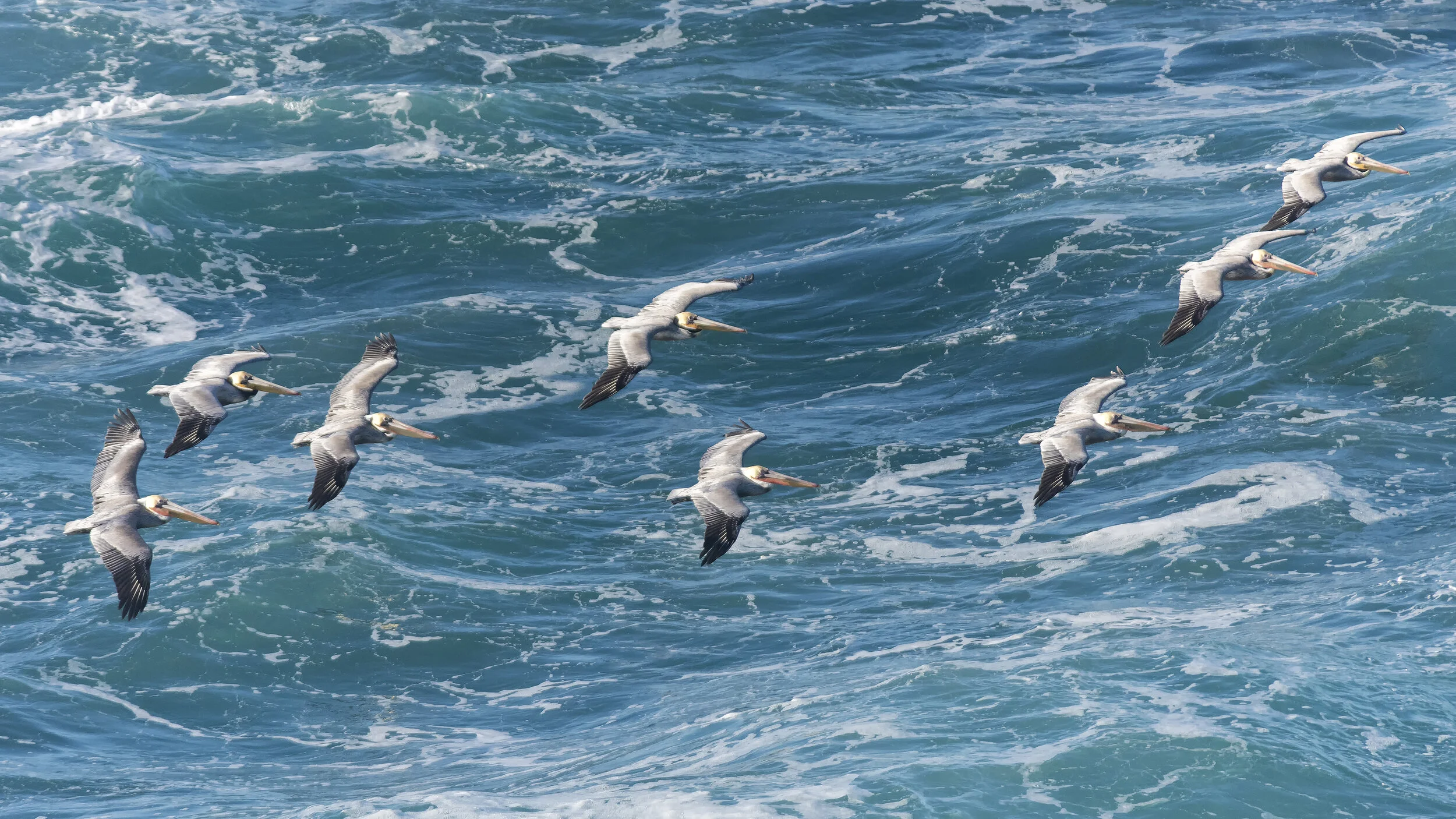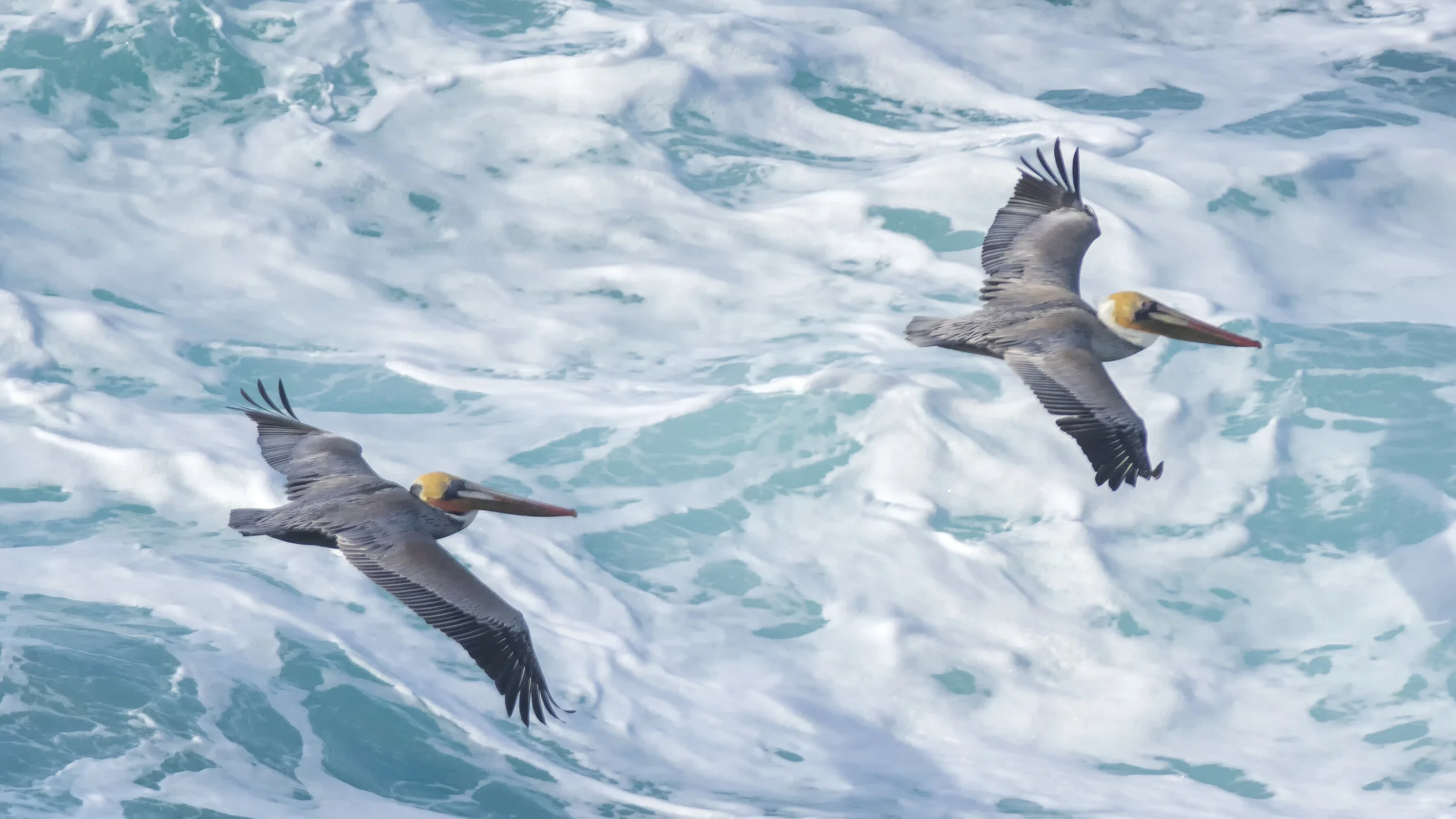California Brown Pelicans: A Story of Survival by Steve Tabor
California Brown Pelicans: A Story of Survival
by Steve Tabor
The California Brown Pelican is one of eight species of the Brown Pelican that are found along the Atlantic, Gulf and Pacific coastlines. Along with the White Pelican, they are the only pelicans native to North America. Although California Brown Pelicans are common to the California coastline, they can be found as far south as Nayarit, Mexico and as far north as Vancouver, British Columbia. But, it was not that long ago that these graceful flyers were brought to the brink of extinction.
As early as the mid-1940’s, California’s agricultural industry and households began to use a pesticide known as Dichlorodiphenyltrichloroethane, DDT. Although it was developed to combat such insect borne diseases such as malaria and typhus, it was commonly used as a pesticide. It’s impact on humans and the environment was not called into question until the early 1960’s.
Coincidentally, scientist began to observe a decline in the California Brown Pelican population. As research continued, scientists discovered that DDT was entering our coastal waters by means of field runoff and city storm drains. The marine life inhabiting our coastal waters ingested the chemical causing a dramatic impact on our sea life and ocean environment. As scientists closely studied DDT’s environmental impact, they discovered that a large number of marine animals including fishes, such as anchovies, sardines and Pacific mackerel, which are primary food sources for pelicans ingested significant amounts of the chemical which was deposited in various parts of their bodies. As the pelicans ingested the fish, they too fell victim to the negative effects of DDT.
The scientists found that ingesting of the DDT altered the pelicans’ ability to metabolizes calcium which impacted the structure of the eggs they laid during their nesting period. As a result, the eggshells were so thin that they could not support the weight of the nesting adults. As the adults sat on the eggs to incubate them, the eggshell would crack, eliminating any chance of producing a pelican chick. By 1970, only 552 nesting attempts were made, and only a small number of chicks survived. In 1972, the wide use of DDT was banned and increased nesting attempts steadily rose.
Although California Brown Pelicans reproductive nesting primarily occurs along the Pacific Coast of Mexico, Anacapa Island and Santa Barbara Island in the Channel Island chain that support nesting colonies, researchers discovered on Anacapa Island between 1969 through 1984, an averaged approximately 900 nesting attempts annually. From 1985 through 2006, the nesting attempts increased to approximately 4,600 per year.
As for Santa Barbara Island, researchers were not able to document any California Brown Pelican nesting attempts until 1980. From 1985-2001, Santa Barbara Island has hosted 770 nesting attempts annually.
These increased nesting attempts have resulted in a 712 percent increase in the California Brown Pelican population in the past 40 years according to the International Union for Conservation of Nature and Natural Resources.
Nesting begins in March and can extend through late summer or early fall. Recently, scientists have noted that some nesting is extending up to eleven months. Nests on the Channel Islands are created on the ground or native scrubs and sometimes along slopes, canyons and along the tops and edges of high bluffs. The success of the breeding season is determined by the supply of food sources near the nesting areas. Without an adequate supply of food, pelicans frequently abandon their nest before the eggs mature. During reproduction, females generally lay three eggs. The parents split incubation duties of the eggs. When they are not nesting, the pelicans search their ocean environment for food.
Pelican chicks are born without feathers and completely dependent on their parents for the first three to four weeks of life. During this time, the adults use their pouches to hold the semi-digested food to feed their chicks. During their 13-week fledging period, the chicks ability to feed themselves becomes their greatest challenge between life and death.
California Brown Pelicans can live up to 40 years. Although males are slightly larger than females, they can weigh up to eight pounds and grow four feet in length with a wingspan of 6½ feet. On land their webbed feet make walking difficult, but in the water their feet and wings allow them to swim up to 21 miles per hour for a short burst of time.
The pelicans’ aerobatic skills often fascinate observers. Pelicans can guide slightly above the water’s surface utilizing an aerodynamic principle known as “ground effect”. The pelican’s speed and its wing structure and size create a cushion of air between the water and pelican that is strong enough to maintain the pelican’s flight. Flying high above, pelicans will often form a staggered line or “V” pattern to utilize aerodynamic air flows to reduce the amount of energy required to maintain their flight.
Brown Pelicans and Peruvian Pelicans are the only species of pelicans that are “plunge” feeders. Instead of floating on the surface of the water and dipping their bills in the water to capture fish, the pelicans fly above the surface of the water and use their keen vision to spot fish swimming below. Once their prey is spotted, the pelican will begin its dive by extending its bill forward and folding its wings back in “V” against its body and plunge into the water. The shock wave created by the pelican’s entry stuns the prey and allows the pelican to scoop up the prey and up to three gallons of water in its pouch that extends below its bill.
The pelican has air sacs throughout its body, in addition to reducing body weight, and providing ventilation and cooling for the pelican, these sacs cushion the blow of entering the water and allow the pelican to surface quickly. Once the pelican reaches the surface, it expels the water from the pouch and traps the fish before tipping its head back and swallowing the fish.
Pelicans can eat up to four pounds per day. Their bills can contain three times the amount of food compared to the size of it stomach. They generally feed within five miles of the shoreline, however, if necessary, they can fly as far as 30 miles looking for food sources. Annually, they consume about one percent of the anchovy biomass off the Southern California coast.
Some populations of the California Brown Pelicans will seasonally migrate. Flocks do move north towards British Columbia in the summer and move south in the early winter.
Resources:
National Park Service
Monterey Bay Aquarium
Aquarium of the Pacific
Steve Tabor Bio
This South Bay native’s photographic journey began after receiving his first 35 mm film camera upon earning his Bachelor of Arts degree. Steve began with photographing coastal landscapes and marine life. As a classroom teacher he used photography to share the world and his experiences with his students. Steve has expanded his photographic talents to include portraits and group photography, special event photography as well as live performance and athletics. Steve serves as a volunteer ranger for the Catalina Island Conservancy and uses this opportunity to document the flora and fauna of the island’s interior as well as photograph special events and activities.
Watch for Steve Tabor Images on the worldwide web.















